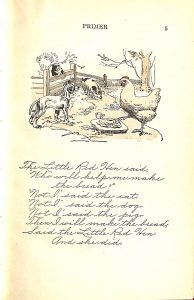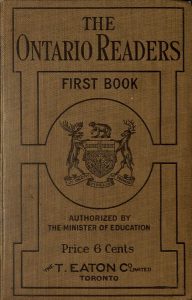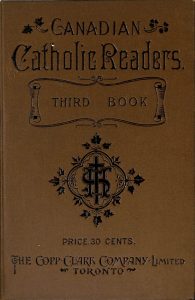 Books of curated stories, or Readers, have been used throughout history for the purpose of teaching children to read and to expose them to literature. Many such readers have been used in Ontario’s history. These readers include the Canadian Series of School Books readers (1867), the Royal Canadian Readers (1883), and many editions of the Ontario Readers (1884, 1909, 1920, 1933). Although new editions would periodically be published, the Readers used in Ontario schools remained fairly consistent in format and content until the Second World War.
Books of curated stories, or Readers, have been used throughout history for the purpose of teaching children to read and to expose them to literature. Many such readers have been used in Ontario’s history. These readers include the Canadian Series of School Books readers (1867), the Royal Canadian Readers (1883), and many editions of the Ontario Readers (1884, 1909, 1920, 1933). Although new editions would periodically be published, the Readers used in Ontario schools remained fairly consistent in format and content until the Second World War.
Learning to read in early Ontario schools began with the Primer. These books presented children with texts written for the express purpose of teaching children to read. As such, the texts in Primers generally contained simple words of one or two syllables and often written using larger fonts. Some of these Primers even broke words down into syllables, such as the 1881 Canadian Readers: Primer II.
 However, the Primers used in early Ontario schools also differed from what we expect to see in schools today. For example, pupils were often taught to read cursive writing as they learned to read. Some, such as the 1920 edition of the Ontario Readers: Primer, even teach children cursive before teaching them print letters! By contrast, today cursive is not typically taught in Ontario schools until grade 3. Furthermore, although the texts presented in Primers were designed to be simple and easy to read, some Primers nevertheless included small print and relatively dense text blocks.
However, the Primers used in early Ontario schools also differed from what we expect to see in schools today. For example, pupils were often taught to read cursive writing as they learned to read. Some, such as the 1920 edition of the Ontario Readers: Primer, even teach children cursive before teaching them print letters! By contrast, today cursive is not typically taught in Ontario schools until grade 3. Furthermore, although the texts presented in Primers were designed to be simple and easy to read, some Primers nevertheless included small print and relatively dense text blocks.
While the texts included in Primers were typically purpose-written, and included adaptations of fairy tales and fables, excerpts from English literature would be progressively included as pupils became more experienced readers. For example, the Second Reader often contained a combination of purpose-written material and excerpts, while the Fourth Reader was comprised entirely of excerpts from classic English literature.  These excerpts came from a wide variety of authors and poets, such as Charles Dickens, Louisa May Alcott, Henry Wadsworth Longfellow, William Wordsworth, John Milton, Robert Louis Stevenson, and Alfred, Lord Tennyson.
These excerpts came from a wide variety of authors and poets, such as Charles Dickens, Louisa May Alcott, Henry Wadsworth Longfellow, William Wordsworth, John Milton, Robert Louis Stevenson, and Alfred, Lord Tennyson.
Readers were not only used to teach pupils how to read and to introduce them to literature. The Golden Rule Books (1915), for example, were a series of Readers used for the moral education of Ontario pupils. Written as a supplement to the 1909 edition of the Ontario Readers, the Golden Rule Books imparted moral lessons using written stories as a medium.
 Furthermore, Catholic schools in Ontario had their own set of Readers approved for use in schools. Examples of the Readers used in Ontario Catholic schools include the Canadian Catholic Readers (1899) and the Canadian Catholic Corona Readers (1930s). The Catholic school Readers largely resembled the public school readers, although they emphasized religious education and included explicitly religious content in the chosen texts. By contrast, the Readers used in public schools were largely secular, although they did include some religious content. For example, the Ontario Readers: Third Book (1909) included a selection of Biblical passages among its content.
Furthermore, Catholic schools in Ontario had their own set of Readers approved for use in schools. Examples of the Readers used in Ontario Catholic schools include the Canadian Catholic Readers (1899) and the Canadian Catholic Corona Readers (1930s). The Catholic school Readers largely resembled the public school readers, although they emphasized religious education and included explicitly religious content in the chosen texts. By contrast, the Readers used in public schools were largely secular, although they did include some religious content. For example, the Ontario Readers: Third Book (1909) included a selection of Biblical passages among its content.
Although today we are used to teachers having some choice in the textbooks they use in their classroom, this was not the case in early Ontario schools. For many years, only one series of readers was approved for use in early Ontario schools at any one time. This meant that all public schools used one set of readers and all Catholic schools used a different set of readers. It was not until the 1950-1951 school year that multiple series of Readers were approved for use in Ontario schools, allowing individual teachers and school boards some choice in which texts they used in their classrooms.
A selection of historical Readers will be on display in the glass table on the ground floor of the OISE Library through the month of December.
